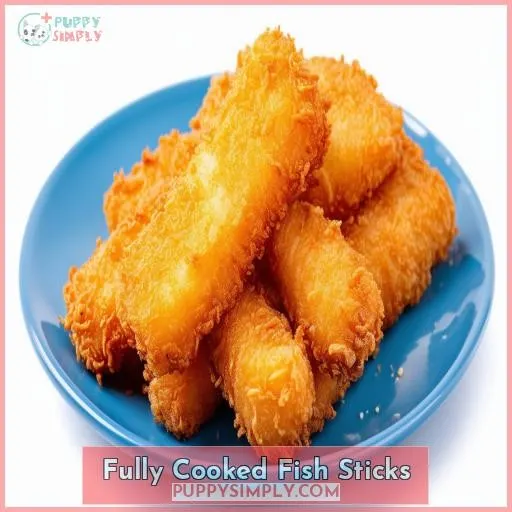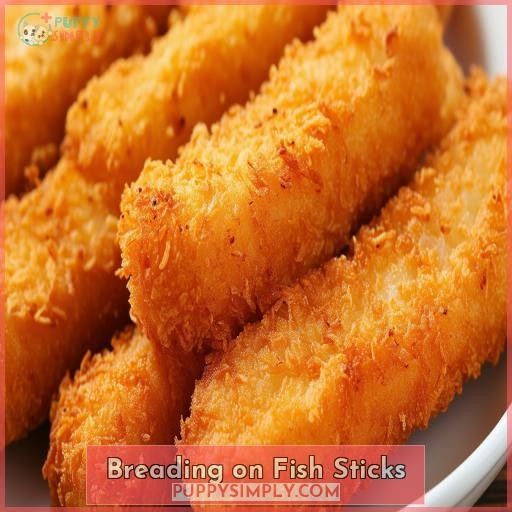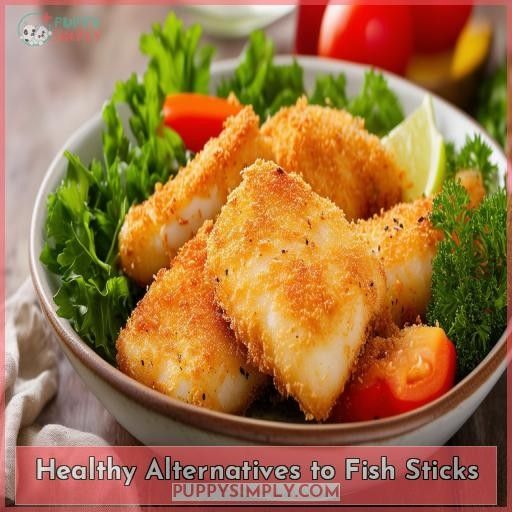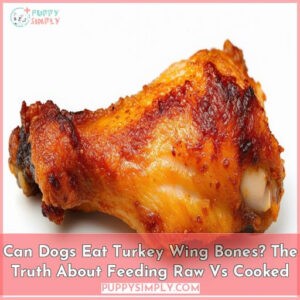This site is supported by our readers. We may earn a commission, at no cost to you, if you purchase through links.
 Dogs can eat fully cooked fish sticks. Always check the label to verify that they are pre-cooked, as uncooked fish can harbor harmful bacteria.
Dogs can eat fully cooked fish sticks. Always check the label to verify that they are pre-cooked, as uncooked fish can harbor harmful bacteria.
The breading is typically made from wheat or corn, which is generally safe for pups. However, monitor for allergies or sensitivities.
For a healthier option, consider homemade fish sticks without unhealthy additives like corn syrup or artificial coloring. Frozen banana slices, cooked chicken, or plain Greek yogurt also make tasty, nutritious treats.
Table Of Contents
Key Takeaways
- Fishing for a new doggy treat? Cast your line for fully cooked fish sticks! Just check that label first – any raw bait could mean an unhealthy catch for your furry first mate.
- While the breading may be plain sailing for most pups, keep an eye peeled for any wheat or corn allergies. If your mutt’s mast starts to list, chart a new course with some homemade, additive-free alternatives instead.
- Bored of the same old biscuits? Reel in some frozen banana slices, cooked chicken pieces, or a scoop of plain Greek yogurt for a healthy snack that’ll have your seafaring canine wagging their tail!
- Steer clear of those processed fish sticks loaded with unhealthy ingredients like corn syrup, artificial colors, and excess salt. Those sketchy snacks could run your pup aground on the rocky shores of obesity and health woes. Stick to the natural stuff for smooth sailing!
Can Dogs Eat Fishsticks?
Yes, dogs can eat fully cooked fish sticks in moderation, but the breading may contain unhealthy ingredients, so plain cooked fish or homemade fish sticks are better options. It’s best to avoid feeding dogs processed snacks like fishsticks regularly.
Fully Cooked Fish Sticks
When considering offering your dog fish sticks, it’s essential to verify the packaging and guarantee that they’re fully cooked before feeding them to your pet. Uncooked or undercooked processed fish can harbor harmful bacteria that could make your dog ill, so it’s critical to avoid giving them anything raw or not thoroughly cooked.
Check for Fully Cooked Label Before Giving to Dogs
You’ll want to check the label for "fully cooked" before giving fish sticks to your furry friend. Fully cooking kills harmful bacteria, making them safer for doggy snacks. If the label doesn’t specify "fully cooked," consider making homemade fish sticks or freezing them again to guarantee they’re pet-safe and nutritious.
Avoid Uncooked Processed Fish Due to Harmful Bacteria
You should also avoid uncooked processed fish due to harmful bacteria. Bacteria like salmonella and listeria can lurk in uncooked, processed seafood products. These pathogens can cause foodborne illnesses in dogs. For safety, always choose fully cooked options, consider homemade alternatives, and take freezing precautions to minimize bacteria contamination and health concerns.
Breading on Fish Sticks
The breading on fish sticks typically contains wheat or corn, which are generally safe for dogs to consume. However, to avoid unhealthy ingredients like excess sodium, artificial colors, and preservatives found in many processed foods, it’s advisable to contemplate making homemade fish sticks for your pup.
Wheat or Corn in Breading is Generally Safe
Most fish stick breading contains wheat or corn – typically safe for dogs. However, you’ll want to monitor for any:
- Wheat allergy symptoms (gas, diarrhea, vomiting)
- Corn allergy signs (skin issues, ear infections)
- Overall digestive discomfort
If concerned, consider homemade alternatives using dog-safe ingredients for a healthier option.
Consider Making Homemade Fish Sticks to Avoid Unhealthy Ingredients
While wheat or corn in the breading is generally safe, you’d be better off making homemade fish sticks to avoid unhealthy ingredients found in factory-processed ones. Here’s a quick rundown on some potential culprits:
| Ingredient | Risk |
|---|---|
| Corn Syrup | Obesity, Diabetes |
| Artificial Colorings | Cancer, Hyperactivity |
| Preservatives | Allergies, Organ Damage |
| Excess Sodium | High Blood Pressure |
| Trans Fats | Heart Disease |
Ditch the fake food and make natural, frozen DIY snacks for your pup instead.
Healthy Alternatives to Fish Sticks
While fish sticks can provide a tasty treat for your pup, there are healthier alternatives to explore. Frozen banana slices, cooked chicken breast pieces, small amounts of frozen peanut butter or plain Greek yogurt, and baked sweet potato chunks offer nutritious options with fewer processed ingredients.
Bananas (sliced and Frozen)
Bananas are an excellent frozen treat for dogs. They’re rich in dietary fiber, potassium for heart health, and magnesium for bone health. Slice and freeze bananas for a healthy, low-calorie snack. Just watch for allergies. Frozen banana pieces provide enrichment as dogs lick and crunch the tasty frozen treats. They freeze well, making banana-based snacks convenient.
Cooked Chicken Breast (cut Into Small Pieces and Frozen)
You can also give your pup cooked chicken breast, diced into bite-sized pieces and frozen for a tasty, protein-packed treat. Freezing makes them last longer and helps clean teeth as your dog chews. Portion sizes matter, though – stick to training reward sizes to avoid weight gain. Homemade is best for controlling ingredients.
Peanut Butter (small Amounts, Frozen)
You can also freeze small amounts of peanut butter as a healthy, protein-rich treat. If your pup is lactose intolerant, frozen peanut butter makes a great alternative to yogurt. However, always introduce new foods gradually and look for potential allergies or intolerances to peanut butter in some dogs.
Plain Greek Yogurt (small Amounts, Frozen)
Plain Greek yogurt is another healthy frozen treat for your pup! Yogurt provides four great benefits: 1) Probiotics that aid digestion, 2) Protein for muscle development, 3) Calcium for strong bones and teeth, and 4) A cool, invigorating snack on hot days. However, be mindful of lactose intolerance and portion control—offer only small frozen amounts.
Baked Sweet Potatoes (cut Into Small Pieces and Frozen)
You can also give your pup frozen baked sweet potato treats. Simply bake some sweet potatoes, cut them into small pieces, and freeze them for a healthy, frozen treat. Your dog will love this sweet, nutritious snack!
| Cold Carrot Coins | Frosty Apple Wedges | Icy Sweet Taters |
|---|---|---|
| Carrot slices | Apple slices | Sweet potato cubes |
| Frozen | Frozen | Frozen |
| Crunchy | Crisp | Soft |
Frozen baked sweet potato pieces make a great doggy dessert or treat alternative you can feel good about giving your furry friend.
Risks of Processed Foods for Dogs
You should be wary of the risks associated with processed foods like fish sticks for your dog. These types of treats are often loaded with unhealthy ingredients such as corn syrup, excessive sodium, and artificial colorings that can contribute to obesity and other health problems in dogs.
Unhealthy Ingredients (corn Syrup, Sodium, Artificial Colorings)
You’ll want to steer clear of fish sticks loaded with artificial sweeteners, high fructose corn syrup, preservatives, and excessive sodium levels.
Many brands pack their products with unhealthy additives like corn syrup, sodium, and artificial colorings that can wreak havoc on your pup’s diet.
Opt for an iffy brand, and you’re setting your furry friend up for a world of added sugars and sketchy ingredients.
Contribute to Obesity and Other Health Problems
You shouldn’t feed your pup processed foods like breaded fish sticks regularly. The unhealthy ingredients can contribute to obesity, diabetes, and other health problems over time. Opt for homemade alternatives like cooked chicken breast instead—cook them all the way through, and watch portion sizes to prevent your furry friend from packing on extra pounds.
Choose Natural and Healthy Treats Whenever Possible
You’ll want to choose natural, sugar-free options that provide benefits like Omega-3s and calcium. Homemade recipes allow you to control ingredients for any allergies. While dogs can tolerate some processed treats in small amounts, you run the risk of unhealthy additives. Greek yogurt and cut-up fruits/veggies offer more natural alternatives.
Frequently Asked Questions (FAQs)
How often can I give fish sticks to my dog?
Flaky fish feasts? Feed fido’s favorites fortnight-ly. Fish’s fine fare fully furnishes furbabies’ feisty fancies. Follow food frequency frugally: Fishsticks furtively furnish fundamental fats furwarding flawless fitness-focus.
Are there any age restrictions for feeding fish sticks?
There aren’t specific age restrictions, but fish sticks can be a tasty treat for dogs of most ages. Avoid giving them to puppies under 4 months old. Monitor your pup’s reaction to any new food and adjust portions accordingly.
Can fish sticks be a complete meal for dogs?
No, fish sticks alone don’t provide complete nutrition for dogs. They lack essential nutrients like fiber, vitamins, and minerals found in a balanced diet. Offer fish sticks as an occasional treat, but rely on high-quality dog food for your pup’s main meals.
Are there specific breeds that should avoid fish sticks?
Remember the time Fido gobbled up those fish sticks you dropped? While most dogs can enjoy them occasionally, certain breeds like pugs or bulldogs may have trouble digesting the breading due to their flat faces. As with any treat, moderation is key for happy, healthy pups.
What are the signs of an allergic reaction to fish?
Watch out for vomiting, diarrhea, itchy skin, and trouble breathing – those could signal an allergy to fish. If you notice any concerning symptoms, it’s best to consult your vet right away.
Conclusion
Ultimately, can dogs eat fishsticks? While fully cooked varieties are generally safe, homemade options without unhealthy additives provide a better nutritional choice for your pup. Explore tasty alternatives like frozen banana slices, cooked chicken, or plain Greek yogurt for ideal health benefits. Prioritize wholesome, natural treats to promote your canine companion’s well-being.










